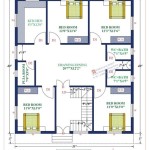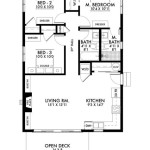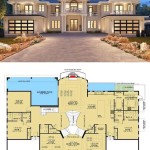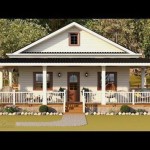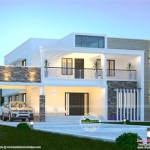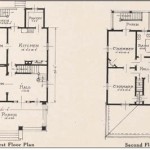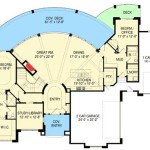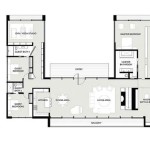One-story house plans are architectural designs for single-level homes that provide convenience and accessibility. They offer a range of benefits, including ease of movement for individuals with mobility challenges, wheelchair accessibility, and reduced maintenance, making them ideal for aging homeowners or those who prefer a more comfortable living experience.
When choosing the best one-story house plans, it is crucial to consider factors such as the number of bedrooms and bathrooms, the layout and flow of the living spaces, the placement of windows and doors for optimal natural lighting and ventilation, and the exterior design to suit personal preferences and the surrounding environment. These plans offer a variety of options to cater to diverse needs and lifestyles.
In this article, we will delve into the key considerations for selecting the best one-story house plans, exploring various design styles, floor plan options, and tips for creating a functional and visually appealing home.
One-story house plans offer numerous advantages, including:
- Enhanced accessibility
- Reduced maintenance
- Energy efficiency
- Functional layout
- Customizable designs
- Variety of styles
- Open floor plans
- Abundant natural light
- Outdoor living spaces
- Aging-in-place options
By carefully considering these factors, homeowners can create a one-story home that meets their specific needs and desires.
Enhanced accessibility
One-story house plans offer enhanced accessibility, making them an ideal choice for individuals with mobility challenges, wheelchair users, and those who prefer a more comfortable and convenient living environment. By eliminating stairs and steps, one-story homes provide easy and safe movement throughout the house.
Wide doorways and hallways allow for effortless wheelchair navigation, while ramps and no-threshold entries ensure smooth transitions between indoor and outdoor spaces. Additionally, accessible features such as grab bars in bathrooms and kitchens, lever handles on doors and faucets, and roll-under sinks provide added convenience and safety.
Open floor plans contribute to the enhanced accessibility of one-story homes. By minimizing walls and barriers, these plans create a more spacious and interconnected living environment, making it easier for individuals to move around and access different areas of the house.
Furthermore, one-story homes can be designed with universal design principles in mind, incorporating features that benefit people of all ages and abilities. These features include non-slip flooring, adjustable countertops and shelves, and smart home technology that can be controlled by voice or touch.
By prioritizing accessibility, one-story house plans empower individuals to live independently and comfortably, regardless of their physical limitations.
Reduced maintenance
One-story house plans offer reduced maintenance compared to multi-story homes, contributing to lower long-term costs and a more manageable lifestyle.
With all living spaces located on a single level, one-story homes eliminate the need for stairs and multiple levels of roofing, gutters, and siding. This reduces the frequency and cost of repairs and replacements associated with these components.
Additionally, one-story homes have a smaller overall footprint compared to multi-story homes with the same square footage. This means less exterior surface area to maintain, including painting, staining, and repairs. The absence of exterior walls on the second story also reduces the risk of water damage and structural issues that can be more common in multi-story homes.
Furthermore, one-story homes provide easier access to all areas of the house, making it more convenient to perform regular maintenance tasks such as cleaning, dusting, and minor repairs. This can help extend the lifespan of the home and its components.
By choosing a one-story house plan, homeowners can enjoy a more manageable and cost-effective living environment, with reduced maintenance requirements and a longer-lasting home.
Energy efficiency
One-story house plans offer inherent advantages for energy efficiency, leading to lower utility costs and a more sustainable living environment.
- Reduced heating and cooling costs
With all living spaces located on a single level, one-story homes have a smaller volume of air to heat and cool compared to multi-story homes. This results in reduced energy consumption and lower utility bills.
- Improved insulation
One-story homes have a larger roof surface area relative to their volume, providing an opportunity for effective insulation. Proper insulation can significantly reduce heat loss in winter and heat gain in summer, further enhancing energy efficiency.
- Optimized window placement
One-story house plans allow for strategic window placement to maximize natural lighting and passive solar heating. By positioning windows on the south-facing side of the home, homeowners can take advantage of sunlight to warm the house during the winter months, reducing the reliance on artificial heating.
- Energy-efficient appliances and systems
One-story homes provide easier access to all areas of the house, making it more convenient to install and maintain energy-efficient appliances and systems. These may include energy-star rated appliances, LED lighting, and smart thermostats that can be remotely controlled to optimize energy usage.
By incorporating energy-efficient features into their one-story house plans, homeowners can create a comfortable and sustainable living environment while minimizing their impact on the environment and reducing their energy expenses.
Functional layout
One-story house plans prioritize functional layouts that maximize space utilization, enhance accessibility, and create a comfortable and efficient living environment.
Open floor plans are a popular choice for one-story homes as they eliminate unnecessary walls and barriers, creating a more spacious and interconnected living area. This open concept design allows for seamless flow between the kitchen, dining room, and living room, fostering a sense of togetherness and making it easier to entertain guests or keep an eye on children.
Well-defined zones within the open floor plan ensure that each area has a specific purpose and function. The kitchen may feature a dedicated cooking space with an island or peninsula for food preparation and casual dining. The living room can be arranged around a cozy fireplace or entertainment system, providing a comfortable space for relaxation and socializing. The dining area can be defined by a chandelier or a designated seating arrangement, creating a more formal space for meals.
Efficient use of space is crucial in one-story house plans. Built-in storage solutions, such as cabinets, shelves, and closets, help keep clutter at bay and maximize functionality. Multi-purpose rooms can serve multiple functions, such as a guest room that doubles as a home office or a playroom that can be converted into a study area as children grow older.
Accessibility considerations are incorporated into functional layouts to ensure that all areas of the home are easily accessible to individuals with mobility challenges or disabilities. Wide doorways, ramps, and no-threshold entries provide smooth transitions throughout the house. Accessible features, such as grab bars in bathrooms and kitchens, lever handles on doors and faucets, and roll-under sinks, enhance safety and convenience.
By carefully considering functional layout, one-story house plans create a living environment that is both comfortable and efficient, meeting the diverse needs of homeowners and providing a high quality of life.
Customizable designs
One-story house plans offer a high degree of customization, allowing homeowners to tailor their homes to their specific needs, preferences, and lifestyles. Unlike pre-designed homes, customizable plans provide flexibility and the ability to create a truly unique living space.
Flexible layouts: Customizable one-story house plans allow for flexibility in the layout and arrangement of rooms. Homeowners can choose the number and size of bedrooms, bathrooms, and living spaces, as well as the placement of windows and doors. This flexibility enables them to create a layout that suits their family’s lifestyle and accommodates their specific needs.
Personalized aesthetics: Customization extends to the exterior and interior aesthetics of the home. Homeowners can select from a range of architectural styles, including traditional, modern, farmhouse, and contemporary. They can also choose exterior finishes, such as siding, roofing, and trim, to match their personal tastes and the surrounding environment.
Unique features: Customizable one-story house plans allow homeowners to incorporate unique features and amenities that reflect their passions and hobbies. These may include gourmet kitchens, home theaters, wine cellars, or dedicated spaces for hobbies such as art studios or music rooms. By incorporating these unique features, homeowners can create a home that is truly their own.
The level of customization available in one-story house plans empowers homeowners to create a living space that perfectly aligns with their dreams and aspirations. By working with an architect or designer, homeowners can transform their vision into a reality, resulting in a home that is both functional and aesthetically pleasing.
Variety of styles
One-story house plans encompass a wide range of architectural styles, each with its own distinct characteristics and appeal. From traditional to modern and everything in between, there is a style to suit every taste and preference.
- Traditional style
Traditional one-story house plans evoke a sense of timeless elegance and charm. They often feature symmetrical facades, gabled roofs, and decorative details such as columns, moldings, and shutters. Traditional-style homes can be found in a variety of sizes and configurations, from cozy cottages to grand mansions.
- Modern style
Modern one-story house plans prioritize clean lines, open spaces, and an abundance of natural light. They often feature flat roofs, large windows, and minimalist facades. Modern-style homes are known for their energy efficiency and functionality, creating a comfortable and stylish living environment.
- Farmhouse style
Farmhouse one-story house plans draw inspiration from traditional farmhouses, characterized by their simple and rustic charm. They often feature wrap-around porches, cozy fireplaces, and open floor plans. Farmhouse-style homes are known for their welcoming and inviting atmosphere, making them a popular choice for families.
- Contemporary style
Contemporary one-story house plans represent the latest trends in architecture, showcasing innovative designs and materials. They often feature geometric shapes, bold colors, and unique rooflines. Contemporary-style homes are known for their striking and visually appealing designs, creating a statement in any neighborhood.
The variety of styles available in one-story house plans provides homeowners with ample choice to find a design that aligns with their aesthetic preferences and lifestyle needs. Whether seeking a classic traditional home, a sleek modern retreat, a charming farmhouse, or a cutting-edge contemporary masterpiece, there is a one-story house plan to suit every taste and desire.
Open floor plans
Open floor plans are a defining characteristic of many modern one-story house plans, offering a spacious and interconnected living environment that promotes a sense of togetherness and flexibility.
- Enhanced flow and connectivity
Open floor plans eliminate unnecessary walls and barriers, creating a seamless flow between different areas of the home. This allows for easy movement and interaction between family members and guests, fostering a sense of community and togetherness.
- Abundant natural light
Open floor plans often feature large windows and a thoughtful arrangement of rooms to maximize natural light penetration. This creates a bright and airy atmosphere throughout the home, reducing the need for artificial lighting and promoting a healthier and more inviting living environment.
- Spaciousness and flexibility
By removing walls and partitions, open floor plans create a more spacious and flexible living area. This allows homeowners to arrange furniture and define different zones within the space according to their needs and preferences. The flexibility of open floor plans makes them suitable for a variety of lifestyles and family dynamics.
- Improved communication and supervision
Open floor plans facilitate better communication and supervision within the home. Parents can easily keep an eye on children playing in the living room while preparing meals in the kitchen. Family members can interact and engage in conversations even when they are in different parts of the house.
Overall, open floor plans in one-story house plans contribute to a more spacious, flexible, and connected living environment that enhances the overall quality of life for homeowners and their families.
Abundant natural light
One-story house plans prioritize abundant natural light, creating a bright and airy living environment that enhances well-being and reduces the need for artificial lighting. This is achieved through thoughtful window placement, skylights, and an overall design that maximizes the penetration of natural light into the home.
Strategic window placement: Windows are strategically placed in one-story house plans to capture natural light from different angles throughout the day. Large windows and sliding glass doors are often used to create a seamless connection between indoor and outdoor spaces, blurring the boundaries and bringing the beauty of nature inside.
Skylights and clerestory windows: Skylights and clerestory windows are incorporated into the design to introduce natural light from above. Skylights provide overhead illumination, reducing the need for artificial lighting during the day. Clerestory windows, positioned high on the walls, allow for natural light to enter even in areas where side windows may be limited.
Open floor plans: Open floor plans, as discussed earlier, contribute to the abundance of natural light in one-story house plans. By eliminating unnecessary walls and partitions, natural light can penetrate deep into the home, reaching even the interior rooms.
The abundant natural light in one-story house plans not only creates a more inviting and healthier living environment but also offers practical benefits. It reduces the reliance on artificial lighting, leading to energy savings. Natural light has been shown to improve mood, boost productivity, and enhance overall well-being.
Outdoor living spaces
One-story house plans often seamlessly integrate indoor and outdoor living spaces, extending the functionality and enjoyment of the home beyond its walls. These outdoor living spaces provide opportunities for relaxation, entertainment, and connection with nature, enhancing the overall quality of life for homeowners.
Patios and decks: Patios and decks are popular outdoor living spaces in one-story house plans. They provide a level, stable surface for outdoor furniture, grilling, and dining. Patios are typically constructed of concrete, pavers, or stone, while decks are elevated platforms made of wood or composite materials. Both options offer a comfortable and inviting space to enjoy the outdoors.
Screened porches and sunrooms: Screened porches and sunrooms offer a protected outdoor living space that extends the usability of the home throughout the year. Screened porches are enclosed with screens to keep out insects while allowing for fresh air and views of the surroundings. Sunrooms, on the other hand, are enclosed with glass windows, providing a more sheltered and temperature-controlled space that can be enjoyed even in inclement weather.
Pergolas and gazebos: Pergolas and gazebos provide shade and shelter from the sun and rain, creating comfortable outdoor living areas. Pergolas are open structures with a latticework or, while gazebos are freestanding structures with a roof and open sides. Both options offer a charming and functional addition to any outdoor space.
Outdoor living spaces in one-story house plans are designed to complement the indoor living areas, providing a seamless transition between the two. They extend the functionality of the home, creating additional spaces for relaxation, entertainment, and enjoyment of the outdoors.
Aging-in-place options
One-story house plans can be designed to incorporate aging-in-place features, which allow individuals to live independently and comfortably in their homes as they age. These features enhance accessibility, safety, and overall well-being, enabling seniors to maintain their quality of life.
- Universal design principles
Universal design principles guide the creation of living spaces that are accessible and usable by individuals of all ages and abilities. One-story house plans that embrace universal design incorporate features such as wider doorways and hallways, lever handles on doors and faucets, and no-threshold entries. These features make it easier for individuals with mobility challenges or disabilities to navigate the home safely and independently.
- Accessible bathrooms
Accessible bathrooms are essential for aging-in-place. They feature roll-in showers with grab bars, raised toilets with grab bars, and non-slip flooring. These modifications provide a safe and comfortable bathing experience for individuals with limited mobility or balance issues.
- First-floor bedrooms
One-story house plans with first-floor bedrooms eliminate the need for stairs, making it easier for seniors to access their sleeping quarters. This is especially important for individuals who may experience mobility challenges or difficulty navigating stairs as they age.
- Smart home technology
Smart home technology can enhance safety and convenience for seniors. Features such as automated lighting, voice-activated controls, and remote monitoring systems allow individuals to manage their home environment with ease. Smart home technology can also provide peace of mind for family members, who can remotely check in on their loved ones and ensure their well-being.
By incorporating aging-in-place options into one-story house plans, homeowners can create a safe, comfortable, and accessible living environment that supports their independence and well-being as they age.










Related Posts

